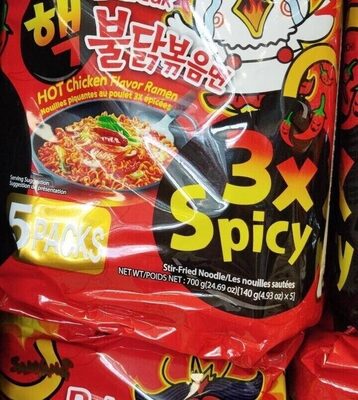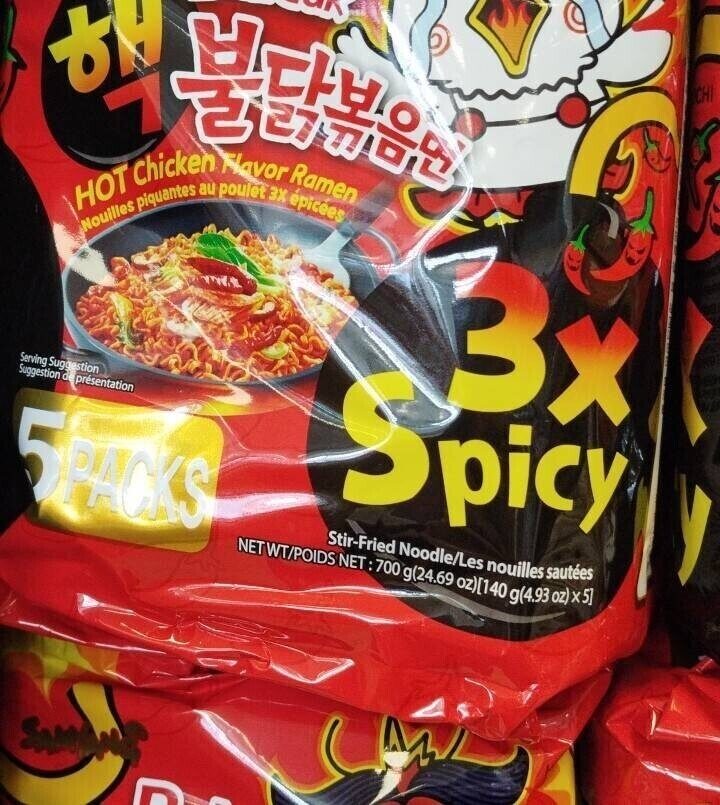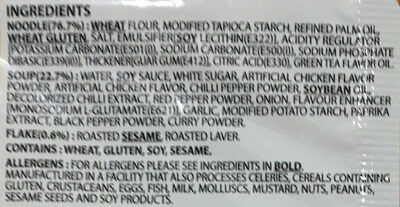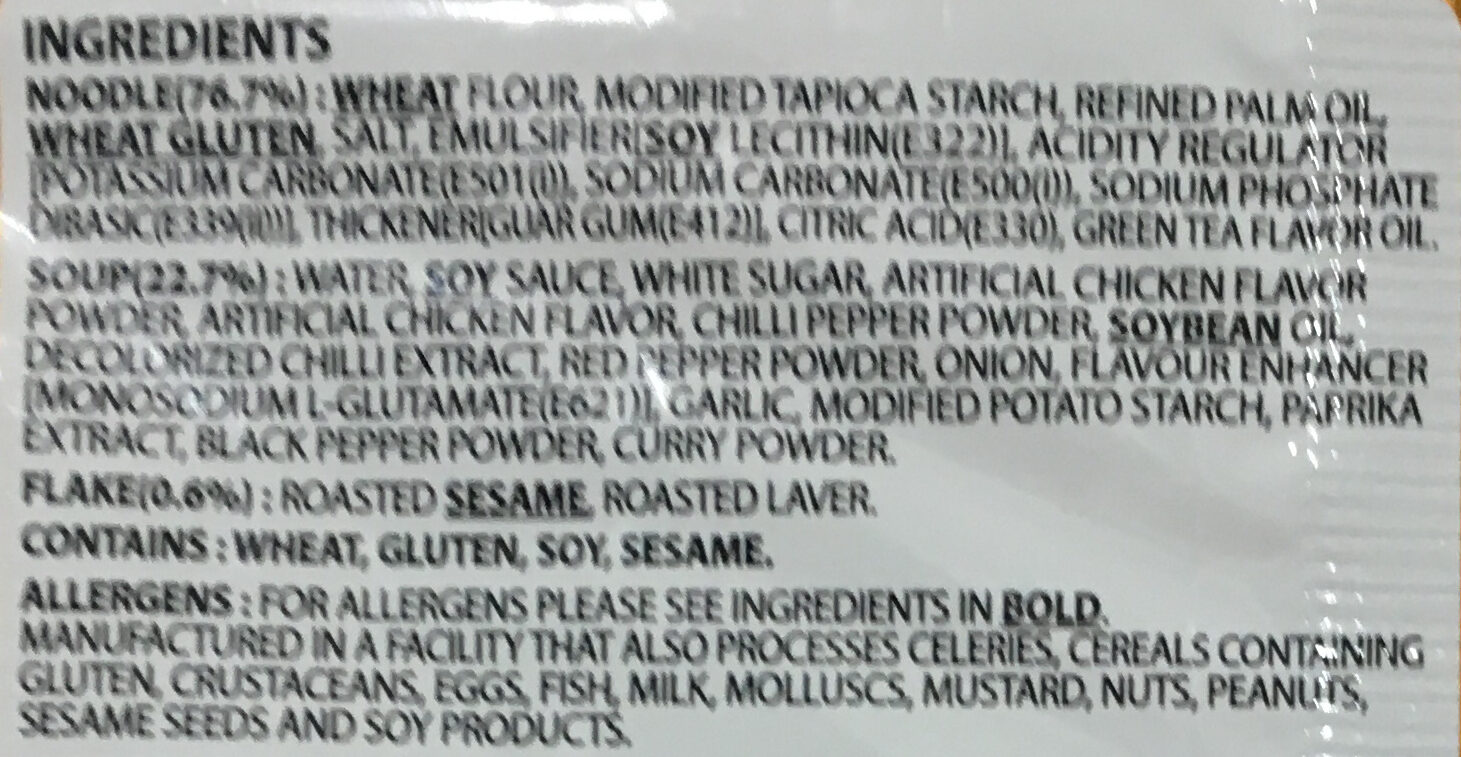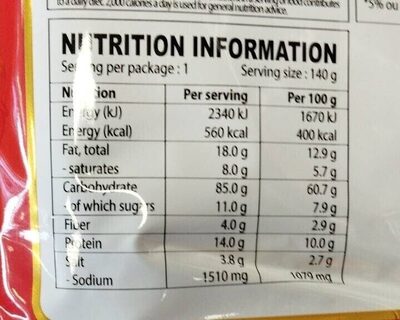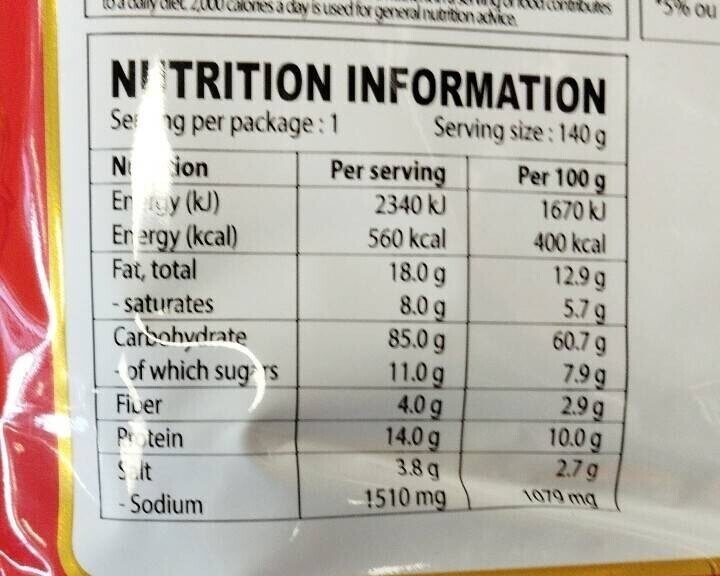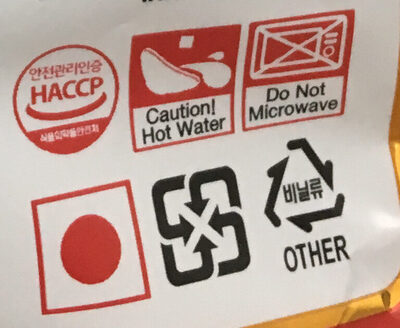Help us make food transparency the norm!
As a non-profit organization, we depend on your donations to continue informing consumers around the world about what they eat.
The food revolution starts with you!
3x spicy noddles - Samyang - 700 g
3x spicy noddles - Samyang - 700 g
This product page is not complete. You can help to complete it by editing it and adding more data from the photos we have, or by taking more photos using the app for Android or iPhone/iPad. Thank you!
×
बारकोड: 8801073142978 (EAN / EAN-13)
मात्रा: 700 g
ब्रांड: Samyang
श्रेणियाँ: en:Plant-based foods and beverages, en:Plant-based foods, en:Dried products, पास्ता, en:Dried products to be rehydrated, en:Noodles, en:Instant noodles
लेबल, प्रमाणपत्र, पुरस्कार:
Halal
दुकाने: Mango Supermarked
जिन देशों में बिकता है: भारत
Matching with your preferences
स्वास्थ्य
सामग्री
-
44 ingredients
अंग्रेज़ी भाषा: NOODLE (76.79%) {WHEAT FLOUR, MODIFIED TAPIOCA STARCH, REFINED PALM OIL, WHEAT GLUTEN, SALT, EMULSIFIER[SOY LECITHIN(E322)], ACIDITY REGULATOR POTASSIUM CARBONATE (E501(), SODIUM CARBONATE(E500(i)), SODIUM PHOSPHATE DIBASIC (E339(ii))], THICKENER[GUAR GUM(E412)], CITRIC ACID(E330), GREEN TEA FLAVOR OIL}. SOUP (22.7%) {WATER, SOY SAUCE, WHITE SUGAR, ARTIFICIAL CHICKEN FLAVOR POWDER, ARTIFICIAL CHICKEN FLAVOR, CHILLI PEPPER POWDER, SOYBEAN OIL, DECOLORIZED CHILLI EXTRACT, RED PEPPER POWDER, ONION, FLAVOUR ENHANCER (MONOSODIUM L-GLUTAMATE(E621), GARLIC, MODIFIED POTATO STARCH, PAPRIKA EXTRACT, BLACK PEPPER POWDER, CURRY POWDER}. FLAKE(0.6%) {ROASTED SESAME, ROASTED LAVER}. CONTAINS: WHEAT, GLUTEN, SOY, SESAME.एलर्जी: en:Gluten, en:Sesame seeds, en:Soybeansअवशेष: en:Crustaceans, en:Eggs, en:Fish, en:Gluten, en:Milk, en:Molluscs, en:Mustard, en:Nuts, en:Peanuts, en:Sesame seeds, en:Soybeans
Food processing
-
Ultra processed foods
Elements that indicate the product is in the en:4 - Ultra processed food and drink products group:
- योज्य: E160c
- योज्य: E322
- योज्य: E412
- योज्य: E621 - मोनोसोडियम ग्लूटामेट
- Ingredient: Emulsifier
- Ingredient: Flavour enhancer
- Ingredient: Gluten
- Ingredient: Thickener
Food products are classified into 4 groups according to their degree of processing:
- Unprocessed or minimally processed foods
- Processed culinary ingredients
- Processed foods
- Ultra processed foods
The determination of the group is based on the category of the product and on the ingredients it contains.
योगशील
-
E322
Lecithin: Lecithin -UK: , US: , from the Greek lekithos, "egg yolk"- is a generic term to designate any group of yellow-brownish fatty substances occurring in animal and plant tissues, which are amphiphilic – they attract both water and fatty substances -and so are both hydrophilic and lipophilic-, and are used for smoothing food textures, dissolving powders -emulsifying-, homogenizing liquid mixtures, and repelling sticking materials.Lecithins are mixtures of glycerophospholipids including phosphatidylcholine, phosphatidylethanolamine, phosphatidylinositol, phosphatidylserine, and phosphatidic acid.Lecithin was first isolated in 1845 by the French chemist and pharmacist Theodore Gobley. In 1850, he named the phosphatidylcholine lécithine. Gobley originally isolated lecithin from egg yolk—λέκιθος lekithos is "egg yolk" in Ancient Greek—and established the complete chemical formula of phosphatidylcholine in 1874; in between, he had demonstrated the presence of lecithin in a variety of biological matters, including venous blood, in human lungs, bile, human brain tissue, fish eggs, fish roe, and chicken and sheep brain. Lecithin can easily be extracted chemically using solvents such as hexane, ethanol, acetone, petroleum ether, benzene, etc., or extraction can be done mechanically. It is usually available from sources such as soybeans, eggs, milk, marine sources, rapeseed, cottonseed, and sunflower. It has low solubility in water, but is an excellent emulsifier. In aqueous solution, its phospholipids can form either liposomes, bilayer sheets, micelles, or lamellar structures, depending on hydration and temperature. This results in a type of surfactant that usually is classified as amphipathic. Lecithin is sold as a food additive and dietary supplement. In cooking, it is sometimes used as an emulsifier and to prevent sticking, for example in nonstick cooking spray.Source: Wikipedia (अंग्रेज़ी भाषा)
-
E322i
Lecithin: Lecithin -UK: , US: , from the Greek lekithos, "egg yolk"- is a generic term to designate any group of yellow-brownish fatty substances occurring in animal and plant tissues, which are amphiphilic – they attract both water and fatty substances -and so are both hydrophilic and lipophilic-, and are used for smoothing food textures, dissolving powders -emulsifying-, homogenizing liquid mixtures, and repelling sticking materials.Lecithins are mixtures of glycerophospholipids including phosphatidylcholine, phosphatidylethanolamine, phosphatidylinositol, phosphatidylserine, and phosphatidic acid.Lecithin was first isolated in 1845 by the French chemist and pharmacist Theodore Gobley. In 1850, he named the phosphatidylcholine lécithine. Gobley originally isolated lecithin from egg yolk—λέκιθος lekithos is "egg yolk" in Ancient Greek—and established the complete chemical formula of phosphatidylcholine in 1874; in between, he had demonstrated the presence of lecithin in a variety of biological matters, including venous blood, in human lungs, bile, human brain tissue, fish eggs, fish roe, and chicken and sheep brain. Lecithin can easily be extracted chemically using solvents such as hexane, ethanol, acetone, petroleum ether, benzene, etc., or extraction can be done mechanically. It is usually available from sources such as soybeans, eggs, milk, marine sources, rapeseed, cottonseed, and sunflower. It has low solubility in water, but is an excellent emulsifier. In aqueous solution, its phospholipids can form either liposomes, bilayer sheets, micelles, or lamellar structures, depending on hydration and temperature. This results in a type of surfactant that usually is classified as amphipathic. Lecithin is sold as a food additive and dietary supplement. In cooking, it is sometimes used as an emulsifier and to prevent sticking, for example in nonstick cooking spray.Source: Wikipedia (अंग्रेज़ी भाषा)
-
E330 - सिट्रिक अम्ल
Citric acid: Citric acid is a weak organic acid that has the chemical formula C6H8O7. It occurs naturally in citrus fruits. In biochemistry, it is an intermediate in the citric acid cycle, which occurs in the metabolism of all aerobic organisms. More than a million tons of citric acid are manufactured every year. It is used widely as an acidifier, as a flavoring and chelating agent.A citrate is a derivative of citric acid; that is, the salts, esters, and the polyatomic anion found in solution. An example of the former, a salt is trisodium citrate; an ester is triethyl citrate. When part of a salt, the formula of the citrate ion is written as C6H5O3−7 or C3H5O-COO-3−3.Source: Wikipedia (अंग्रेज़ी भाषा)
-
E339ii
Sodium phosphates: Sodium phosphate is a generic term for a variety of salts of sodium -Na+- and phosphate -PO43−-. Phosphate also forms families or condensed anions including di-, tri-, tetra-, and polyphosphates. Most of these salts are known in both anhydrous -water-free- and hydrated forms. The hydrates are more common than the anhydrous forms.Source: Wikipedia (अंग्रेज़ी भाषा)
-
E412
Guar gum: Guar gum, also called guaran, is a galactomannan polysaccharide extracted from guar beans that has thickening and stabilizing properties useful in the food, feed and industrial applications. The guar seeds are mechanically dehusked, hydrated, milled and screened according to application. It is typically produced as a free-flowing, off-white powder.Source: Wikipedia (अंग्रेज़ी भाषा)
-
E500
Sodium carbonate: Sodium carbonate, Na2CO3, -also known as washing soda, soda ash and soda crystals, and in the monohydrate form as crystal carbonate- is the water-soluble sodium salt of carbonic acid. It most commonly occurs as a crystalline decahydrate, which readily effloresces to form a white powder, the monohydrate. Pure sodium carbonate is a white, odorless powder that is hygroscopic -absorbs moisture from the air-. It has a strongly alkaline taste, and forms a moderately basic solution in water. Sodium carbonate is well known domestically for its everyday use as a water softener. Historically it was extracted from the ashes of plants growing in sodium-rich soils, such as vegetation from the Middle East, kelp from Scotland and seaweed from Spain. Because the ashes of these sodium-rich plants were noticeably different from ashes of timber -used to create potash-, they became known as "soda ash". It is synthetically produced in large quantities from salt -sodium chloride- and limestone by a method known as the Solvay process. The manufacture of glass is one of the most important uses of sodium carbonate. Sodium carbonate acts as a flux for silica, lowering the melting point of the mixture to something achievable without special materials. This "soda glass" is mildly water-soluble, so some calcium carbonate is added to the melt mixture to make the glass produced insoluble. This type of glass is known as soda lime glass: "soda" for the sodium carbonate and "lime" for the calcium carbonate. Soda lime glass has been the most common form of glass for centuries. Sodium carbonate is also used as a relatively strong base in various settings. For example, it is used as a pH regulator to maintain stable alkaline conditions necessary for the action of the majority of photographic film developing agents. It acts as an alkali because when dissolved in water, it dissociates into the weak acid: carbonic acid and the strong alkali: sodium hydroxide. This gives sodium carbonate in solution the ability to attack metals such as aluminium with the release of hydrogen gas.It is a common additive in swimming pools used to raise the pH which can be lowered by chlorine tablets and other additives which contain acids. In cooking, it is sometimes used in place of sodium hydroxide for lyeing, especially with German pretzels and lye rolls. These dishes are treated with a solution of an alkaline substance to change the pH of the surface of the food and improve browning. In taxidermy, sodium carbonate added to boiling water will remove flesh from the bones of animal carcasses for trophy mounting or educational display. In chemistry, it is often used as an electrolyte. Electrolytes are usually salt-based, and sodium carbonate acts as a very good conductor in the process of electrolysis. In addition, unlike chloride ions, which form chlorine gas, carbonate ions are not corrosive to the anodes. It is also used as a primary standard for acid-base titrations because it is solid and air-stable, making it easy to weigh accurately.Source: Wikipedia (अंग्रेज़ी भाषा)
-
E500i - क्षारातु प्रांगारीय
Sodium carbonate: Sodium carbonate, Na2CO3, -also known as washing soda, soda ash and soda crystals, and in the monohydrate form as crystal carbonate- is the water-soluble sodium salt of carbonic acid. It most commonly occurs as a crystalline decahydrate, which readily effloresces to form a white powder, the monohydrate. Pure sodium carbonate is a white, odorless powder that is hygroscopic -absorbs moisture from the air-. It has a strongly alkaline taste, and forms a moderately basic solution in water. Sodium carbonate is well known domestically for its everyday use as a water softener. Historically it was extracted from the ashes of plants growing in sodium-rich soils, such as vegetation from the Middle East, kelp from Scotland and seaweed from Spain. Because the ashes of these sodium-rich plants were noticeably different from ashes of timber -used to create potash-, they became known as "soda ash". It is synthetically produced in large quantities from salt -sodium chloride- and limestone by a method known as the Solvay process. The manufacture of glass is one of the most important uses of sodium carbonate. Sodium carbonate acts as a flux for silica, lowering the melting point of the mixture to something achievable without special materials. This "soda glass" is mildly water-soluble, so some calcium carbonate is added to the melt mixture to make the glass produced insoluble. This type of glass is known as soda lime glass: "soda" for the sodium carbonate and "lime" for the calcium carbonate. Soda lime glass has been the most common form of glass for centuries. Sodium carbonate is also used as a relatively strong base in various settings. For example, it is used as a pH regulator to maintain stable alkaline conditions necessary for the action of the majority of photographic film developing agents. It acts as an alkali because when dissolved in water, it dissociates into the weak acid: carbonic acid and the strong alkali: sodium hydroxide. This gives sodium carbonate in solution the ability to attack metals such as aluminium with the release of hydrogen gas.It is a common additive in swimming pools used to raise the pH which can be lowered by chlorine tablets and other additives which contain acids. In cooking, it is sometimes used in place of sodium hydroxide for lyeing, especially with German pretzels and lye rolls. These dishes are treated with a solution of an alkaline substance to change the pH of the surface of the food and improve browning. In taxidermy, sodium carbonate added to boiling water will remove flesh from the bones of animal carcasses for trophy mounting or educational display. In chemistry, it is often used as an electrolyte. Electrolytes are usually salt-based, and sodium carbonate acts as a very good conductor in the process of electrolysis. In addition, unlike chloride ions, which form chlorine gas, carbonate ions are not corrosive to the anodes. It is also used as a primary standard for acid-base titrations because it is solid and air-stable, making it easy to weigh accurately.Source: Wikipedia (अंग्रेज़ी भाषा)
-
E501
Potassium carbonate: Potassium carbonate -K2CO3- is a white salt, which is soluble in water -insoluble in ethanol- and forms a strongly alkaline solution. It can be made as the product of potassium hydroxide's absorbent reaction with carbon dioxide. It is deliquescent, often appearing a damp or wet solid. Potassium carbonate is used in the production of soap and glass.Source: Wikipedia (अंग्रेज़ी भाषा)
-
E501i - पोटासियम कार्बोनेट
Potassium carbonate: Potassium carbonate -K2CO3- is a white salt, which is soluble in water -insoluble in ethanol- and forms a strongly alkaline solution. It can be made as the product of potassium hydroxide's absorbent reaction with carbon dioxide. It is deliquescent, often appearing a damp or wet solid. Potassium carbonate is used in the production of soap and glass.Source: Wikipedia (अंग्रेज़ी भाषा)
-
E621 - मोनोसोडियम ग्लूटामेट
Monosodium glutamate: Monosodium glutamate -MSG, also known as sodium glutamate- is the sodium salt of glutamic acid, one of the most abundant naturally occurring non-essential amino acids. Glutamic acid is found naturally in tomatoes, grapes, cheese, mushrooms and other foods.MSG is used in the food industry as a flavor enhancer with an umami taste that intensifies the meaty, savory flavor of food, as naturally occurring glutamate does in foods such as stews and meat soups. It was first prepared in 1908 by Japanese biochemist Kikunae Ikeda, who was trying to isolate and duplicate the savory taste of kombu, an edible seaweed used as a base for many Japanese soups. MSG as a flavor enhancer balances, blends, and rounds the perception of other tastes.The U.S. Food and Drug Administration has given MSG its generally recognized as safe -GRAS- designation. A popular belief is that large doses of MSG can cause headaches and other feelings of discomfort, known as "Chinese restaurant syndrome," but double-blind tests fail to find evidence of such a reaction. The European Union classifies it as a food additive permitted in certain foods and subject to quantitative limits. MSG has the HS code 29224220 and the E number E621.Source: Wikipedia (अंग्रेज़ी भाषा)
Ingredients analysis
-
en:Palm oil
Ingredients that contain palm oil: en:Refined palm oil
-
en:Vegan status unknown
Unrecognized ingredients: en:sodium-phosphate-dibasic, E339ii, en:soup, en:artificial-chicken-flavor-powder, en:artificial-chicken-flavor, en:decolorized-chilli-extract, en:flakeSome ingredients could not be recognized.
We need your help!
You can help us recognize more ingredients and better analyze the list of ingredients for this product and others:
- Edit this product page to correct spelling mistakes in the ingredients list, and/or to remove ingredients in other languages and sentences that are not related to the ingredients.
- Add new entries, synonyms or translations to our multilingual lists of ingredients, ingredient processing methods, and labels.
If you would like to help, join the #ingredients channel on our Slack discussion space and/or learn about ingredients analysis on our wiki. Thank you!
-
en:Vegetarian status unknown
Unrecognized ingredients: en:sodium-phosphate-dibasic, E339ii, en:soup, en:artificial-chicken-flavor-powder, en:artificial-chicken-flavor, en:decolorized-chilli-extract, en:flakeSome ingredients could not be recognized.
We need your help!
You can help us recognize more ingredients and better analyze the list of ingredients for this product and others:
- Edit this product page to correct spelling mistakes in the ingredients list, and/or to remove ingredients in other languages and sentences that are not related to the ingredients.
- Add new entries, synonyms or translations to our multilingual lists of ingredients, ingredient processing methods, and labels.
If you would like to help, join the #ingredients channel on our Slack discussion space and/or learn about ingredients analysis on our wiki. Thank you!
-
Details of the analysis of the ingredients
We need your help!
Some ingredients could not be recognized.
We need your help!
You can help us recognize more ingredients and better analyze the list of ingredients for this product and others:
- Edit this product page to correct spelling mistakes in the ingredients list, and/or to remove ingredients in other languages and sentences that are not related to the ingredients.
- Add new entries, synonyms or translations to our multilingual lists of ingredients, ingredient processing methods, and labels.
If you would like to help, join the #ingredients channel on our Slack discussion space and/or learn about ingredients analysis on our wiki. Thank you!
en: NOODLE 76.7209511439704% (WHEAT FLOUR, MODIFIED TAPIOCA STARCH, REFINED PALM OIL, WHEAT GLUTEN, SALT, EMULSIFIER (SOY LECITHIN (e322)), ACIDITY REGULATOR (POTASSIUM CARBONATE, e501), SODIUM CARBONATE (e500i), SODIUM PHOSPHATE DIBASIC (e339ii), THICKENER (GUAR GUM (e412)), CITRIC ACID (e330), GREEN TEA FLAVOR OIL), SOUP 22.6795883704666% (WATER, SOY SAUCE, WHITE SUGAR, ARTIFICIAL CHICKEN FLAVOR POWDER, ARTIFICIAL CHICKEN FLAVOR, CHILLI PEPPER, SOYBEAN OIL, DECOLORIZED CHILLI EXTRACT, RED PEPPER, ONION, FLAVOUR ENHANCER, MONOSODIUM L-GLUTAMATE (e621), GARLIC, MODIFIED POTATO STARCH, PAPRIKA EXTRACT, BLACK PEPPER, CURRY), FLAKE 0.599460485562993% (SESAME, LAVER)- NOODLE -> en:noodle - vegan: maybe - vegetarian: maybe - percent_min: 76.7209511439704 - percent: 76.7209511439704 - percent_max: 76.7209511439704
- WHEAT FLOUR -> en:wheat-flour - vegan: yes - vegetarian: yes - ciqual_proxy_food_code: 9410 - percent_min: 6.39341259533087 - percent_max: 76.7209511439704
- MODIFIED TAPIOCA STARCH -> en:modified-tapioca-starch - vegan: yes - vegetarian: yes - ciqual_proxy_food_code: 9510 - percent_min: 0 - percent_max: 38.3604755719852
- REFINED PALM OIL -> en:refined-palm-oil - vegan: yes - vegetarian: yes - from_palm_oil: yes - ciqual_food_code: 16150 - percent_min: 0 - percent_max: 25.5736503813235
- WHEAT GLUTEN -> en:wheat-gluten - vegan: yes - vegetarian: yes - percent_min: 0 - percent_max: 19.1802377859926
- SALT -> en:salt - vegan: yes - vegetarian: yes - ciqual_food_code: 11058 - percent_min: 0 - percent_max: 2.6975
- EMULSIFIER -> en:emulsifier - percent_min: 0 - percent_max: 2.6975
- SOY LECITHIN -> en:soya-lecithin - vegan: yes - vegetarian: yes - ciqual_food_code: 42200 - percent_min: 0 - percent_max: 2.6975
- e322 -> en:e322 - vegan: maybe - vegetarian: maybe - percent_min: 0 - percent_max: 2.6975
- SOY LECITHIN -> en:soya-lecithin - vegan: yes - vegetarian: yes - ciqual_food_code: 42200 - percent_min: 0 - percent_max: 2.6975
- ACIDITY REGULATOR -> en:acidity-regulator - percent_min: 0 - percent_max: 2.6975
- POTASSIUM CARBONATE -> en:e501i - vegan: yes - vegetarian: yes - percent_min: 0 - percent_max: 2.6975
- e501 -> en:e501 - vegan: yes - vegetarian: yes - percent_min: 0 - percent_max: 1.34875
- SODIUM CARBONATE -> en:e500i - vegan: yes - vegetarian: yes - percent_min: 0 - percent_max: 2.6975
- e500i -> en:e500i - vegan: yes - vegetarian: yes - percent_min: 0 - percent_max: 2.6975
- SODIUM PHOSPHATE DIBASIC -> en:sodium-phosphate-dibasic - percent_min: 0 - percent_max: 2.6975
- e339ii -> en:e339ii - percent_min: 0 - percent_max: 2.6975
- THICKENER -> en:thickener - percent_min: 0 - percent_max: 2.6975
- GUAR GUM -> en:e412 - vegan: yes - vegetarian: yes - percent_min: 0 - percent_max: 2.6975
- e412 -> en:e412 - vegan: yes - vegetarian: yes - percent_min: 0 - percent_max: 2.6975
- GUAR GUM -> en:e412 - vegan: yes - vegetarian: yes - percent_min: 0 - percent_max: 2.6975
- CITRIC ACID -> en:e330 - vegan: yes - vegetarian: yes - percent_min: 0 - percent_max: 2.6975
- e330 -> en:e330 - vegan: yes - vegetarian: yes - percent_min: 0 - percent_max: 2.6975
- GREEN TEA FLAVOR OIL -> en:green-tea-aroma-oil - vegan: yes - vegetarian: yes - ciqual_food_code: 18155 - percent_min: 0 - percent_max: 2.6975
- SOUP -> en:soup - percent_min: 22.6795883704666 - percent: 22.6795883704666 - percent_max: 22.6795883704666
- WATER -> en:water - vegan: yes - vegetarian: yes - ciqual_food_code: 18066 - percent_min: 1.33409343355686 - percent_max: 22.6795883704666
- SOY SAUCE -> en:soy-sauce - vegan: maybe - vegetarian: maybe - ciqual_food_code: 11104 - percent_min: 0 - percent_max: 11.3397941852333
- WHITE SUGAR -> en:white-sugar - vegan: yes - vegetarian: yes - ciqual_food_code: 31016 - percent_min: 0 - percent_max: 7.55986279015552
- ARTIFICIAL CHICKEN FLAVOR POWDER -> en:artificial-chicken-flavor-powder - percent_min: 0 - percent_max: 5.66989709261664
- ARTIFICIAL CHICKEN FLAVOR -> en:artificial-chicken-flavor - percent_min: 0 - percent_max: 4.53591767409331
- CHILLI PEPPER -> en:chili-pepper - vegan: yes - vegetarian: yes - ciqual_food_code: 20151 - percent_min: 0 - percent_max: 3.77993139507776
- SOYBEAN OIL -> en:soya-oil - vegan: yes - vegetarian: yes - from_palm_oil: no - ciqual_food_code: 17420 - percent_min: 0 - percent_max: 3.23994119578094
- DECOLORIZED CHILLI EXTRACT -> en:decolorized-chilli-extract - percent_min: 0 - percent_max: 2.83494854630832
- RED PEPPER -> en:red-bell-pepper - vegan: yes - vegetarian: yes - ciqual_food_code: 20087 - percent_min: 0 - percent_max: 2.51995426338517
- ONION -> en:onion - vegan: yes - vegetarian: yes - ciqual_food_code: 20034 - percent_min: 0 - percent_max: 2.26795883704666
- FLAVOUR ENHANCER -> en:flavour-enhancer - percent_min: 0 - percent_max: 2.06178076095151
- MONOSODIUM L-GLUTAMATE -> en:e621 - vegan: yes - vegetarian: yes - percent_min: 0 - percent_max: 1.88996569753888
- e621 -> en:e621 - vegan: yes - vegetarian: yes - percent_min: 0 - percent_max: 1.88996569753888
- GARLIC -> en:garlic - vegan: yes - vegetarian: yes - ciqual_food_code: 11000 - percent_min: 0 - percent_max: 1.74458372080512
- MODIFIED POTATO STARCH -> en:modified-potato-starch - vegan: yes - vegetarian: yes - ciqual_proxy_food_code: 9510 - percent_min: 0 - percent_max: 1.61997059789047
- PAPRIKA EXTRACT -> en:e160c - vegan: yes - vegetarian: yes - percent_min: 0 - percent_max: 1.5119725580311
- BLACK PEPPER -> en:black-pepper - vegan: yes - vegetarian: yes - ciqual_food_code: 11015 - percent_min: 0 - percent_max: 1.41747427315416
- CURRY -> en:curry - vegan: yes - vegetarian: yes - ciqual_food_code: 11005 - percent_min: 0 - percent_max: 1.41747427315416
- FLAKE -> en:flake - percent_min: 0.599460485562993 - percent: 0.599460485562993 - percent_max: 0.599460485562986
- SESAME -> en:sesame - vegan: yes - vegetarian: yes - ciqual_food_code: 15010 - percent_min: 0.299730242781497 - percent_max: 0.599460485562986
- LAVER -> en:laver - vegan: yes - vegetarian: yes - ciqual_proxy_food_code: 20984 - percent_min: 0 - percent_max: 0.299730242781489
-
पोषण तथ्य
पोषण तथ्य As sold
for 100 g / 100 mlAs sold
प्रत्येक हिस्सा (140g)Compared to: en:Instant noodles ऊर्जा 1,670 kj
(400 kcal)2,340 kj
(560 kcal)-3% वसा 12.9 g 18.1 g -15% Saturated fat 5.7 g 7.98 g -25% Carbohydrates 60.7 g 85 g +3% शर्करा 7.9 g 11.1 g +221% Fiber 2.9 g 4.06 g +29% प्रोटीन 10 g 14 g +19% साधारण नमक 2.698 g 3.78 g -4% Fruits‚ vegetables‚ nuts and rapeseed‚ walnut and olive oils (estimate from ingredients list analysis) 0.173 % 0.173 %
वातावरण
-
Eco-Score C - Moderate environmental impact
⚠ ️The full impact of transportation to your country is currently unknown.The Eco-Score is an experimental score that summarizes the environmental impacts of food products.→ The Eco-Score was initially developped for France and it is being extended to other European countries. The Eco-Score formula is subject to change as it is regularly improved to make it more precise and better suited to each country.Life cycle analysis
-
Average impact of products of the same category: A (Score: 82/100)
वर्ग: Asian noodles, flavoured, dehydrated
वर्ग: Asian noodles, flavoured, dehydrated
- PEF environmental score: 0.26 (the lower the score, the lower the impact)
- including impact on climate change: 1.67 kg CO2 eq/kg of product
Stage Impact Agriculture
65.5 %Processing
20.6 %पैकेजिंग
8.7 %Transportation
3.5 %Distribution
1.8 %Consumption
0.0 %
Bonuses and maluses
-
Missing origins of ingredients information
Malus:
⚠ ️ The origins of the ingredients of this product are not indicated.
If they are indicated on the packaging, you can modify the product sheet and add them.
If you are the manufacturer of this product, you can send us the information with our free platform for producers.
-
Ingredients that threatens species
Malus: -10
Contains palm oil
Tropical forests in Asia, Africa and Latin America are destroyed to create and expand oil palm tree plantations. The deforestation contributes to climate change, and it endangers species such as the orangutan, the pigmy elephant and the Sumatran rhino.
-
Packaging with a high impact
Malus: -15
Shape Material Recycling Impact 1 Wrapper 90 C/X Discard High 5 Wrapper 90 C/X Discard High ⚠ ️ The information about the packaging of this product is not sufficiently precise (exact shapes and materials of all components of the packaging).⚠ ️ For a more precise calculation of the Eco-Score, you can modify the product page and add them.
If you are the manufacturer of this product, you can send us the information with our free platform for producers.
Eco-Score for this product
-
Impact for this product: C (Score: 52/100)
उत्पाद: 3x spicy noddles - Samyang - 700 g
Life cycle analysis score: 82
Sum of bonuses and maluses: -25
Final score: 52/100
-
कार्बन पदचिह्न
-
Equal to driving 0.9 km in a petrol car
167 g CO² per 100g of product
The carbon emission figure comes from ADEME's Agribalyse database, for the category: Asian noodles, flavoured, dehydrated (Source: ADEME Agribalyse Database)
Stage Impact Agriculture
61.0 %Processing
14.9 %पैकेजिंग
16.3 %Transportation
6.8 %Distribution
1.0 %Consumption
0.0 %
पैकेजिंग
-
Packaging with a high impact
-
Packaging parts
1 x Wrapper 5 (90 C/X: 8.3 g)
5 x Wrapper 1 (90 C/X: 3.4 g)
-
Packaging materials
Material % Packaging weight Packaging weight per 100 g of product
-
Transportation
-
Origins of ingredients
Missing origins of ingredients information
⚠ ️ The origins of the ingredients of this product are not indicated.
If they are indicated on the packaging, you can modify the product sheet and add them.
If you are the manufacturer of this product, you can send us the information with our free platform for producers.Add the origins of ingredients for this product Add the origins of ingredients for this product
Threatened species
-
Contains palm oil
Drives deforestation and threatens species such as the orangutan
Tropical forests in Asia, Africa and Latin America are destroyed to create and expand oil palm tree plantations. The deforestation contributes to climate change, and it endangers species such as the orangutan, the pigmy elephant and the Sumatran rhino.
Report a problem
-
Incomplete or incorrect information?
Category, labels, ingredients, allergens, nutritional information, photos etc.
If the information does not match the information on the packaging, please complete or correct it. Open Food Facts is a collaborative database, and every contribution is useful for all.
Data sources
Product added on द्वारा openfoodfacts-contributors
Last edit of product page on द्वारा kiliweb.
उत्पाद पृष्ठ द्वारा संपादित भी foodvisor, odinh, off.8c7d5be6-4ea4-4280-80d0-498557c0ee13, roboto-app, teolemon, yuka.sY2b0xO6T85zoF3NwEKvlnFDS9vGhzjnbyzSmlWKyea1Fabac-hCwairKKs.
